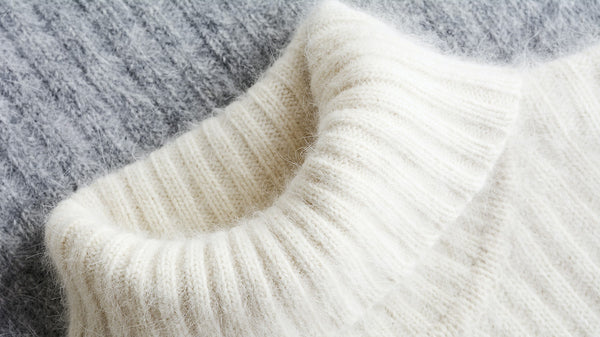Discover the Allure of Cashmere a Natural Fiber: Why It's a Must-Have in Your Closet
The appeal of cashmere, a deluxe all-natural fiber, goes beyond plain visual appeals. From discussing its interesting origin to comprehending its manufacturing treatment, process, and high quality, it's worth discovering why cashmere holds such an unique location in the world of textiles.

The Origin and History of Cashmere: A Brief Summary
While lots of may see cashmere as a simple deluxe, its background is steeped in rich social custom. Stemming from the Kashmir region in India, cashmere wool has actually been created for thousands of years. The fiber is gotten from the soft undercoat of cashmere goats, collected during their molting period. As a priceless product, it was traded along the Silk Road, coming to be extremely valued in Europe in the 18th century. The name 'cashmere' is an old English derivation of Kashmir. Despite its global appeal, most of cashmere manufacturing still stays in Asia, particularly China and Mongolia. This historical trip highlights the cultural significance of cashmere, changing it from a regional specialty to a global deluxe.
Understanding the Unique Properties of Cashmere Fiber
Cashmere, renowned for its distinctive features, sticks out on the planet of textiles. This lavish fiber is extremely soft, giving a cozy and comfortable feeling unlike any other. It is significantly warmer than wool, making it an excellent choice for wintertime garments. Regardless of its warmth, cashmere is surprisingly lightweight and does not include unnecessary bulk. This natural fiber is likewise recognized for its resilience. While other materials might use down with time, cashmere retains its high quality, making certain long-lasting wear. Finally, cashmere possesses a special visual allure. Its gentle appeal and sophistication make it a staple in premium style. Recognizing these homes makes clear why cashmere is not simply a deluxe, yet a rewarding investment for any type of closet.

The Refine of Making Cashmere: From Goat to Garment
To appreciate the lavish residential or commercial properties of cashmere totally, one must comprehend its trip from the raw fiber to the ended up product. The process begins with the cashmere goats, mainly located in Mongolia, China, and Iran. The soft undercoat of these goats, harvested during their all-natural molting period in springtime, gives the raw material. This delicate fiber is after that thoroughly separated from the coarser external hair in a labor-intensive procedure called dehairing. The pure cashmere is after that dyed, spun right into yarn, and finally weaved or woven right into the desirable garments. Each action is meticulously performed to protect cashmere's significant heat, soft qualities, and durability. This detailed process results in the creation of a really glamorous material.

Translating the High Quality and Rate: Why Is Cashmere so Expensive?
The steep cost tag of cashmere garments usually leaves consumers questioning concerning its justification. The cost stems largely from the arduous production process. is cashmere a natural fiber. Cashmere stems from the great undercoat of the cashmere goat, this article with each goat generating a mere 150 grams yearly. The labor-intensive procedure of brushing and accumulating the rare fiber substantially drives up the expense. The processing of raw cashmere calls for both time and competence, with the fibers requiring to be meticulously arranged, cleaned, and rotated. Furthermore, the scarcity of pure cashmere, coupled with its superior softness, warmth, and resilience, validates its high-end condition and high cost. These elements integrated make cashmere a pricy yet highly sought-after commodity in the globe of style.
Cashmere in Fashion: The Adaptability and Timeless Appeal
In spite of its high rate, the ageless allure and adaptability of cashmere have actually solidified its area in the world of fashion. The learn the facts here now fiber's unique appearance, defined by its softness and heat, has become identified with high-end and convenience. Its versatility extends past seasonal trends, making it a closet crucial in different forms, from sophisticated sweaters to chic headscarfs. The versatile nature of cashmere enables for its integration right into both formal and laid-back attire, symbolizing its broad charm. The material's sustaining appeal over the years confirms to its classic charm. As patterns reoccured, cashmere remains a continuous, its attraction undiminished, remaining to shape the style and motivate industry's landscape.
Caring for Your Cashmere: Maintenance and Preservation Tips
Guaranteeing the long life of cashmere garments calls for certain treatment and attention. These prized ownerships must not be thrown right into the cleaning device with routine laundry. Instead, hand cleaning with gentle, pH-neutral soap in lukewarm water is encouraged. After cleaning, they need to not be wrung out. Rather, they must be carefully pressed between towels to absorb excess water, then laid flat to completely dry. Normal cleaning with a cashmere comb can protect against pilling. Saving these things in a trendy, dry area, ideally in a breathable bag, can shield them from moths and moisture (is cashmere a natural fiber). An occasional airing outside, away from direct sunshine, can rejuvenate the fibers. With these upkeep and preservation suggestions, one can ensure their cashmere stays luxuriously soft and sturdy.
Conclusion
Cashmere, with its exceptional softness and heat, supplies both luxury and durability. Its beginning from the Kashmir region and thorough production procedure add to its high-end charm and cost. Its convenience in vogue and enduring appeal make it a worthy financial investment for try this site any closet. With proper treatment and preservation, cashmere garments can last for several years, providing an one-of-a-kind blend of convenience, style, and top quality. Discover the allure of cashmere and raise your style collection.

Comments on “Understanding the Special Qualities of cashmere fibre for Superior Comfort”